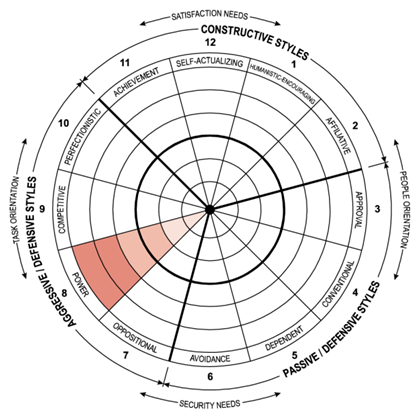In a previous article, we introduced the Human Synergistics Circumplex™, a proven framework to measure, report, discuss and better understand individual and collective human behaviours, and their impact upon business and organisation performance (refer: Catching Smoke: A Proven Framework for Addressing Culture and Leadership).
This latest article focuses on another of the Aggressive/Defensive styles – Power: what it’s all about, how when excessive it can hinder your personal effectiveness and the performance of your business/organisation and how to, at a personal and/or workplace culture level, reduce Power-oriented thinking and behaviour.

So Just What is the Power Style?
Whether we’re looking at it from an individual leadership or broader workplace culture perspective, the Power style is characterised by a desire for status and influence and a tendency to dictate rather than coach, encourage and support the actions of others.
Leaders high in the Power style may tend to, for example:
- Become agitated or angry easily and quickly
- Be forceful in terms of their actions, language, body language etc..
- Feel a need to be in charge (and be seen to be in charge) at all times
- See money, job titles and possessions as the key indicators of success, and
- Become anxious or even fearful when not in control.
Workplace cultures can themselves become Power-oriented, with participants feeling expected or implicitly required to, for example:
- Always appear to be in control
- Be direct, aggressive, forceful
- “Play the game” in order to get ahead, and
- At all times, maintain their level of authority and status.
So Why Should I/We Focus on Limiting the Power Style?
In both individual leadership and workplace culture contexts, excessive Power tendencies can hinder performance. Indeed, research over several decades by Human-Synergistics has consistently shown that leaders and workplaces cultures high in Power and other Aggressive/Defensive styles tend to be significantly less effective, particularly in the longer-term, than those with predominantly Constructive styles.
From a workplace culture perspective for example, primarily Constructive workplaces:
- are 32% more able to effectively respond to changes in the external environment
- achieve 32% higher quality performance
- demonstrate 28% more effective teamwork
- have a 25% greater commitment to producing a quality result
- include individuals that are 32% more motivated, 26% more satisfied and 25% more likely to stay with the organisation.
At an individual level, leaders high in the Power style generally have less productive and satisfying relationships with others and as a result, ultimately struggle to optimise the performance of their teams.
At a broader culture level, while some people can thrive for a period of time in a Power-oriented environment, it will often ultimately result in burnout and/or relationships that become so strained as to be unworkable. Many other people will experience significant and sustained dissatisfaction working in such an environment and will either move on or make a decision to “keep my head down, stay out of the way and just do what I’m told and no more” in order to survive. Whichever of these scenarios play out (and it could well be all of them, depending on your team!), it’s not the type of workplace culture that will drive high engagement or results.
Limiting Power Thinking, Behaviours and Culture
If you think you could improve your effectiveness as a leader by limiting your tendencies toward Power thinking and behaviour, try for example:
- Not controlling everything. Take a step back (small steps at first), bite your tongue, sit on your hands and see what happens, you might be surprised!
- Focusing on building at least one close, trusting relationship within the workplace, then reflect on that experience (Is it personally satisfying? Is it helping you be more effective? How is the other person responding?)
- Try also building your Affiliative and Humanistic-Encouraging styles. Focus on listening, asking questions, supporting the ideas and suggestions of others. Be mindful of your body language and tone.
- Ask yourself where your Power tendencies might be coming from. Why is it so important to you that you are seen to be in charge, that you are seen as “successful”? The answer may well provide a clue as to how you can moderate potentially problematic tendencies.
To limit Power-related expectations at a collective/workplace level, you could try:
- Eliminating or at least reducing symbols related to status and positional power (eg. reserved parking spots by the front door!)
- Acknowledging, encouraging and genuinely responding to contributions from the quiet achievers and/or those with less positional authority.
- Being sure to respond constructively rather than aggressively to mistakes or missed targets.
- Highlighting and celebrating examples of cooperative, constructive behaviour that have achieved results.
- Formulating, communicating and holding people accountable for meeting clear expectations of professional, constructive behaviour (eg. make it clear that yelling, demeaning, controlling, blaming behaviour will not be tolerated).
Next month we’ll take a look at the what, why and how of the final workplace culture and personal leadership style in the Human Synergistics circumplex – Dependent. In the meantime, be sure to call if you’d like to explore the range of culture and leadership programs we have available to help transform your people, your team and your business/organisation.
If you’ve missed our previous articles on the other styles, be sure to search our blog for the “Focus on Culture and Leadership” series of articles.

